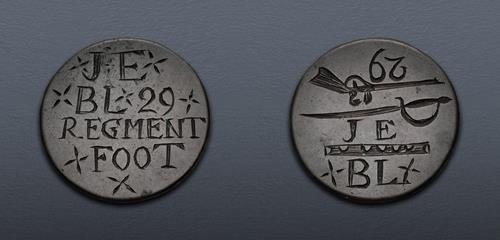|
CU Half Penny Token Remembrance Token (28mm, 7.01 g, 9h). Made from an uncertain Conder halfpenny token. (star) J (star) E (star)/(star) B L (star) 29 (star)/REGMENT/(star) FOOT/(star) (sic) engraved in five lines / (saber left)/J E/(ornate dividing bar)/(star) BL (star) in four lines; inverted above, 29 above British Land Pattern Musket (“Brown Bess”) left. Brown surfaces. Good VF. Rare.
Tokens of remembrance related to military service are a popular area for collectors of exonumia. The most common items are the so-called “sweetheart jewelry” (specifically, mass-produced military-related jewelry given to the sweethearts of enlisted men and officers), and were popular during World Wars I and II. Earlier examples tend to be quite rare and are often placed under the general heading of “love tokens” (generally, one-off issues, made from minor silver denominations and engraved with the beloved’s initials). The presence of military insignia on the token, however, does not automatically assign it to the category of “sweetheart jewelry,” as is the case with the token in CNG E-541, lot 860. This token is described as a “love token,” although, the individuals are friends and perhaps comrades of the same unit. Sharing their wartime experiences, the two formed a friendship that could be called brotherly love (as many in the trenches attested in the post-war period).
Our current token is of a similar nature. Made from an uncertain Conder token halfpenny, it is engraved with the initials of the sender and recipient on both sides, on one side is included the legend 29 REGMENT FOOT (sic); on the other side the same numeral 29, accompanied by a saber and British Land Pattern Musket (“Brown Bess”). The British Land Pattern Musket was the standard long gun of the British Empire’s land forces from 1722-1838 – encompassing the wars in America and in Europe against Napoleon (probably at the time that this token was made).
The 29th Regiment of Foot, formed in 1694 as Thomas Farrington’s Regiment of Foot, was reformed during the War of the Spanish Succession in 1702 and joined the Duke of Marlborough in Flanders in 1704. Unable to participate in the Battle of Blenheim, it nevertheless participated in the Battle of Ramillies and the Siege of Ostend, before being posted to Gibraltar for the next three decades. Between 1740 and 1748, the 29th was stationed in British North America for the War of the Austrian Succession, where it earned the nickname “Ever Sworded,” due to officers being ordered to carry swords and sidearms even while off duty. Remaining in North America after the 1748 Treaty of Aix-la-Chapelle, the regiment helped establish the town of Halifax, Nova Scotia In 1751, the unit’s name was formally changed to the 29th Regiment of Foot. Posted along with the 14th Regiment of Foot to Boston, Massachusetts in 1768, members of the Regiment were in the Boston Massacre (5 March 1770), for which the unit was later dubbed “Vein Openers” for drawing the first blood of the Revolution. Those who participated in this event were defended by the lawyer John Adams, who later became first Vice President and second President of the United States.
During the War of the First Coalition (1792-1797), the 29th Regiment of Foot participated in the Glorious First of June as marines on board HMS Brunswick and HMS Ramillies. During this time, the unit’s number were greatly reduced, due to battle casualties and disease. In 1808, the 29th Regiment of Foot served under Arthur Wellesley (later the Duke of Wellington) during the Peninsular War. Following that, they were redeployed to Nova Scotia during the War of 1812, but did not see service. In 1815, the 29th Regiment of Foot were recalled to Europe to participate in the Hundred Days campaign, but arrived shortly after Napoleon’s defeat at Waterloo.
Who the J E and B L noted on this token were may be lost to history. A British Army Muster Pay List for the 29th Regiment of Foot (5 December 1813-24 March 1814), however lists six privates as possibilities for the J E: James Eady; John Eaton; James Eaton; James Eaves; John Evans; and James Ewen. Future research may uncover more.
Closing Date and Time: 19 July 2023 at 14:19:20 ET.
All winning bids are subject to an 20% buyer’s fee.
|
